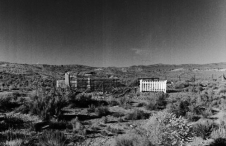Battle Mountain
Battle Mountain owes its early existence to railroads and mining. When the Central Pacific Railroad came to the area in 1868, it encountered a loose community of mining camps inspired by the boomtown of Austin, ninety miles to the south. Mining activity increased with the coming of the railroad, and a post office was established in 1870.
In 1880, Battle Mountain supported a population of 522, and was an important meeting point for the Nevada Central Railroad, which connected Austin with the Central Pacific. Battle Mountain eked out an existence over the next one hundred years, with an economy based on shipping, mining, and livestock.
Battle Mountain's name is the subject of historical debate. Many historians cite a conflict between Native Americans and immigrants as the origin, but details of those skirmishes are sketchy at best. A common story is that the town was named by prospector George Tannihill, who claimed he waged a battle against American Indians with twenty-three other settlers in 1857. This story, along with others, remains unsubstantiated.
In the 1960s and 1970s, the town's economy enjoyed a surge based on copper mining, and its growth was such that the state legislature moved the seat of Lander County from Austin to Battle Mountain in 1979. During the 1980s, the town revolved around the mining of barite, a heavy compound used in oil production. Gold mining showed promise in the late 1980s, but even that was short-lived, and today the future base of Battle Mountain's economy is uncertain. In 2000, the population was estimated at 2,871.
Article Locations
Related Articles
Further Reading
None at this time.



